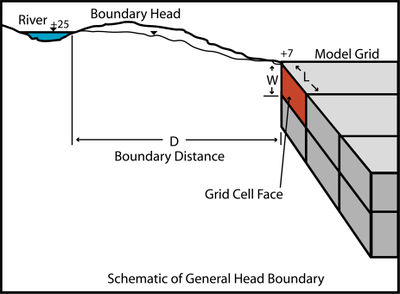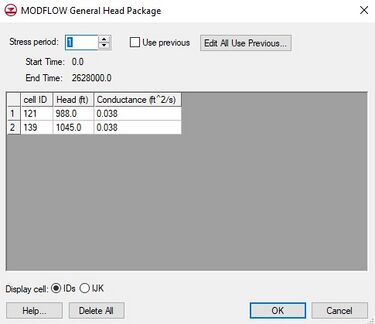|
|
| (9 intermediate revisions by 2 users not shown) |
| Line 1: |
Line 1: |
| {{MODFLOW Links}} | | {{MODFLOW Links}} |
| ==General Head Boundary== | | ==General Head Boundary== |
| The GHB conceptually is a fixed head far from the model where it is assume as a fixed head with time (i.e.: river, head will not be affected by the model stresses with time). The purpose of using this boundary condition is to avoid unnecessarily extending the model domain outward to meet the element influencing the head in the model. As a result, the General head condition is usually assigned along the outside edged of the model domain. | | The General Head Boundary (GHB) conceptually is a fixed head far from the model where it is assume as a fixed head with time (i.e. river, head will not be affected by the model stresses with time). The purpose of using this boundary condition is to avoid unnecessarily extending the model domain outward to meet the element influencing the head in the model. As a result, the general head condition is usually assigned along the outside edged of the model domain. |
|
| |
|
| [[File:General Head Boundary.jpg|thumb|none|400 px|Schematic of General Head Boundary.]] | | [[File:General Head Boundary.jpg|thumb|none|400 px|Schematic of General Head Boundary.]] |
| Line 15: |
Line 15: |
|
| |
|
| ==General Head Package Dialog== | | ==General Head Package Dialog== |
| [[File:MODFLOW-GHB.jpg|thumb|275 px|Example of the ''MODFLOW General Head Package'' dialog]] | | [[File:MODFLOW-GHB.jpg|thumb|375 px|Example of the ''MODFLOW General Head Package'' dialog]] |
|
| |
|
| The General Head package is similar to the [[GMS:DRN Package|Drain]] and [[GMS:RIV Package|River]] packages in that flow in or out of a cell is proportional to a difference in head. General head cells are often used to simulate lakes. General head conditions are specified by assigning a head and a conductance to a selected set of cells. If the water table elevation rises above the specified head, water flows out of the aquifer. If the water table elevation falls below the specified head, water flows into the aquifer. In both cases, the flow rate is proportional to the head difference and the constant of proportionality is the conductance. | | The General Head package is similar to the [[GMS:DRN Package|Drain]] (DRN) and [[GMS:RIV Package|River]] (RIV) packages in that flow in or out of a cell is proportional to a difference in head. General head cells are often used to simulate lakes. General head conditions are specified by assigning a head and a conductance to a selected set of cells. If the water table elevation rises above the specified head, water flows out of the aquifer. If the water table elevation falls below the specified head, water flows into the aquifer. In both cases, the flow rate is proportional to the head difference and the constant of proportionality is the conductance. |
|
| |
|
| A set of selected cells can be specified as general head cells using the '''Point Sources/Sinks''' command in ''MODFLOW'' menu or general heads can be assigned using the [[GMS:MODFLOW Conceptual Model Approach|conceptual model]] in the [[GMS:Map Module|Map module]]. When the general head attribute is assigned to a polygons, the head and conductance are applied uniformly over the entire polygon. When assigned to an arc, the conductance is applied uniformly over the arc, but separate head values are applied to each of the nodes on the ends of the arc and the head is assumed to vary linearly between the nodes. When the attribute is assigned to a point, the head and conductance values are assigned directly to the cell containing the point. Once a set of cells have been specified, the ''General Head Package'' dialog can be used to view and edit the values assigned to the cells. | | A set of selected cells can be specified as general head cells using the '''Point Sources/Sinks''' command in ''MODFLOW'' menu or general heads can be assigned using the [[GMS:MODFLOW Conceptual Model Approach|conceptual model]] in the [[GMS:Map Module|Map module]]. When the general head attribute is assigned to a polygons, the head and conductance are applied uniformly over the entire polygon. When assigned to an arc, the conductance is applied uniformly over the arc, but separate head values are applied to each of the nodes on the ends of the arc and the head is assumed to vary linearly between the nodes. When the attribute is assigned to a point, the head and conductance values are assigned directly to the cell containing the point. Once a set of cells have been specified, the ''General Head Package'' dialog can be used to view and edit the values assigned to the cells. |
| Line 41: |
Line 41: |
| ==Related Topics== | | ==Related Topics== |
| * [[GMS:Conductance|Conductance]] | | * [[GMS:Conductance|Conductance]] |
| | |
|
| |
|
| {{Navbox GMS}} | | {{Navbox GMS}} |
| [[Category:MODFLOW]] | | [[Category:MODFLOW]] |
| | [[Category:MODFLOW-USG]] |
| [[Category:MODFLOW Packages]] | | [[Category:MODFLOW Packages]] |
| [[Category:GMS Dialogs|G]] | | [[Category:MODFLOW Dialogs]] |
| [[Category:Equations]] | | [[Category:Equations]] |
| MODFLOW |
|---|
| Pre-processing |
|---|
|
MODFLOW Commands |
|
Building a MODFLOW Model |
|
Map to MODFLOW |
|
Calibration |
|
Packages Supported in GMS |
|
Saving a MODFLOW Simulation |
|
Importing MODFLOW Files |
|
Unsupported MODFLOW Features |
|
Run MODFLOW |
| Post-processing |
|---|
|
MODFLOW Display Options |
|
MODFLOW Post-Processing Viewing Options |
|
Reading a MODFLOW Simulation |
| Tutorials |
|---|
| Packages |
|---|
| Flow: |
BCF6, HUF, LPF, UPW |
|---|
| Solvers: |
DE4, GMG, NWT, PCG,
PCGN, LMG, SIP, SOR,
SMS |
|---|
| Other: |
BAS6, BFH, CHD1, CLN,
DRN1, DRT1, EVT1, ETS1,
GAGE, GHB1, GNC, HFB1,
HUF, LAK3, MNW1, MNW2,
OUT1, RCH1, RIV1, SFR2,
STR1, SUB1, SWI2, WEL1,
UZF1 |
|---|
|
General Head Boundary
The General Head Boundary (GHB) conceptually is a fixed head far from the model where it is assume as a fixed head with time (i.e. river, head will not be affected by the model stresses with time). The purpose of using this boundary condition is to avoid unnecessarily extending the model domain outward to meet the element influencing the head in the model. As a result, the general head condition is usually assigned along the outside edged of the model domain.

Schematic of General Head Boundary.
Where:
- – K is the average hydraulic conductivity.
- – W is the thickness of the saturated aquifer perpendicular to the flow direction.
- – L is the boundary length perpendicular to the flow direction.
- – D is the distance from the general head boundary to the model boundary.
- – The GHB is the head at far distance where it is fixed (doesn’t change with time)
The conductance for the arc = 
General Head Package Dialog

Example of the
MODFLOW General Head Package dialog
The General Head package is similar to the Drain (DRN) and River (RIV) packages in that flow in or out of a cell is proportional to a difference in head. General head cells are often used to simulate lakes. General head conditions are specified by assigning a head and a conductance to a selected set of cells. If the water table elevation rises above the specified head, water flows out of the aquifer. If the water table elevation falls below the specified head, water flows into the aquifer. In both cases, the flow rate is proportional to the head difference and the constant of proportionality is the conductance.
A set of selected cells can be specified as general head cells using the Point Sources/Sinks command in MODFLOW menu or general heads can be assigned using the conceptual model in the Map module. When the general head attribute is assigned to a polygons, the head and conductance are applied uniformly over the entire polygon. When assigned to an arc, the conductance is applied uniformly over the arc, but separate head values are applied to each of the nodes on the ends of the arc and the head is assumed to vary linearly between the nodes. When the attribute is assigned to a point, the head and conductance values are assigned directly to the cell containing the point. Once a set of cells have been specified, the General Head Package dialog can be used to view and edit the values assigned to the cells.
Stress Period
The stress period field shows the current stress period and allows users to cycle through the stress periods and view the different general head properties for those stress periods in the spreadsheet below.
Use Previous
Use this option on a stress period to use the general head values from the previous stress period for the current stress period. This option is unavailable for steady state models and the first stress period of transient models.
Edit All Use Previous
This button brings up a spreadsheet allowing the user to quickly edit the Use Previous flag for all stress periods.
Spreadsheet
For cells where river type boundary conditions have been assigned, the stage, conductance, bottom elevation , and conductance factor assigned to each cell are displayed in the spreadsheet portion at the lower part of the dialog. The spreadsheet can be used to edit the row, column, layer, head, and conductance values. For a transient simulation, the values displayed in the spreadsheet are for an individual stress period. The values associated with other stress periods can be edited by entering the number of the desired stress period in the stress period edit box in the center of the dialog. If the Use previous option is selected for a given stress period, the values from the previous stress period are used and the spreadsheet is dimmed. The conductance factor is used with HFB parameters. When doing parameter estimation the value of head conductance assigned to a particular head boundary condition will be the value of the head parameter multiplied by the conductance factor. For more information on HFB parameters and conductance factors see the MODFLOW 2000 manual.
Display Cell IDs/IJK
The radio group at the bottom of the dialog allows the user to adjuster whether the cell ID or the cell i, j, k values are displayed for the cells containing the boundary condition/source/sink.
Delete All
The Delete All button deletes all of the data currently defined in the River package and restores the River package parameters to the default values.
Related Topics


